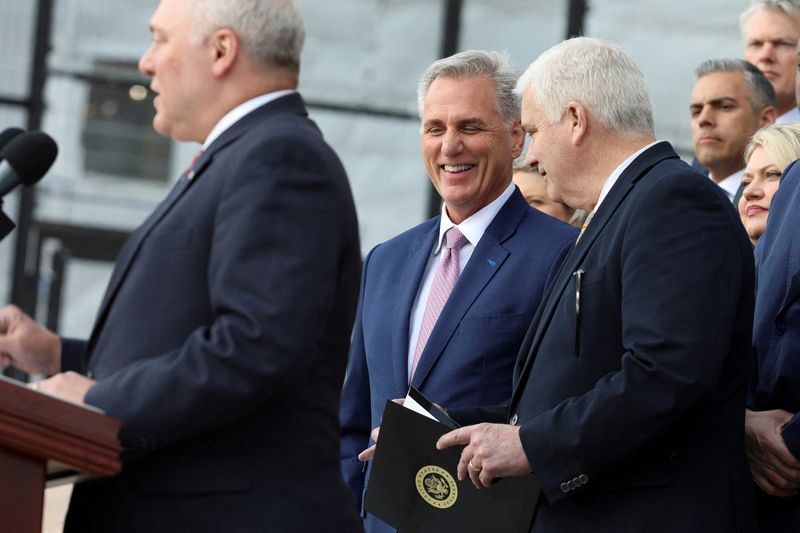By Richard Cowan and Andy Sullivan
WASHINGTON (Reuters) -Republican U.S. House Speaker Kevin McCarthy on Wednesday unveiled a plan to raise the nation's debt ceiling by $1.5 trillion and cut federal spending by three times that amount, laying out an opening position in what is likely to be a tense partisan debate over government borrowing.
McCarthy's proposal, which he unveiled on the floor of the House of Representatives, would cut the total amount of domestic and military spending to 2022 levels and cap growth at 1% annually in years to come. It would not touch retirement and health programs that are projected to expand dramatically as the population ages.
President Joe Biden and the Democratic-controlled Senate are likely to reject the proposals, but McCarthy said they would serve as the basis for negotiations between the two parties over raising the federal government's $31.4 trillion debt limit in the coming weeks. Failure to raise the debt ceiling would lead to default that would shake the U.S. and world economies.
McCarthy's plan would also repeal green-energy incentives signed into law by Biden last year, boost domestic oil and gas production and scrap his $400 billion student-loan forgiveness effort.
It would claw back unspent COVID-19 relief money, cancel a recent budget increase for the Internal Revenue Service and impose stiffer work requirements for some benefit programs.
Congress would gain greater power to block Biden administration regulations under the proposal as well.
McCarthy said the package would lower spending by $4.5 trillion over the coming 10 years. That would not be enough to eliminate budget deficits that are projected to add more than $20 trillion to the national debt over that time period.
"President Biden has a choice: Come to the table and stop playing partisan political games, or cover his ears, refuse to negotiate and risk bumbling his way into the first default in our nation's history," McCarthy said on the House floor.
He did not say when the House of Representatives, which his Republicans control by a narrow 222-213 majority, would vote on the plan.
Biden reiterated his position that Congress should raise the $31.4 trillion debt limit without conditions, as it did three times under his Republican predecessor, Donald Trump.
"Take default off the table, and let's have a real serious, detailed conversation about how to grow the economy, lower costs and reduce the deficit," he said at an appearance outside Washington.
Biden's budget, released last month, would save $3 trillion over 10 years largely through tax hikes.
POTENTIAL CONSEQUENCES
The nonpartisan Committee for a Responsible Federal Budget praised McCarthy's plan as a "realistic and extremely welcome first step." But Democratic Representative Richard Neal dismissed it as "not serious."
The U.S. federal government has already reached the borrowing limit and by this summer is expected to hit a point where it will no longer be able to meet its financial obligations without action by the divided Congress.
Treasury Secretary Janet Yellen has warned the federal government could run out of ways to cover its debts by as soon as early June.
The $1.5 trillion increase proposed by McCarthy could cover the government's needs until early next year, setting the stage for another debt ceiling fight in the midst of the 2024 presidential election campaign.

It was unclear whether McCarthy's plan would unite House Republicans. A sizeable contingent of hardline members have dismissed the risks of failure to act, while others might balk at its limits on military spending.
A lengthy 2011 standoff over the debt ceiling led to a first-ever downgrade of the federal government's credit rating, which rattled markets and raised borrowing costs.